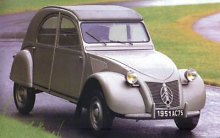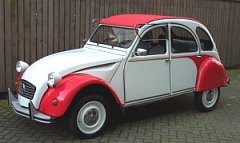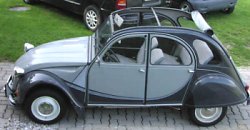 In the mid-1930s, Citroen started developing a revolutionary car which would be known as 2CV. Like Volkswagen of the same era, 2CV was designed to be a "people's car" and put the whole country on wheels. But in many ways the baby Citroen was an even more advanced design, being more innovative, more practical yet even cheaper than the Hitler-funded Volkswagen. Unlike Ford Model T and Volkswagen, Citroen 2CV was not targeted at citizens and workers, but the majority of populations of France, i.e, farmers. It therefore opened a new class, serving those previously could not afford a car. This car had to be cheap, simple to produce, robust and frugal to run. It should be capable of 40 mph, carry 4 people on board plus a big bag of potato. To deal with the rough country roads in France, it should have a good suspension so that the farmers could carry a basket of eggs without worrying breaking them. Like Volkswagen, Citroen had completed 250 pilot cars before WWII broke out. Then their fate differed. While the German car was converted to military use, Citroen had to destroy the pilot cars and bury the prototypes during the period German occupied France. When the war was over, it saw the light again and eventually entered production in 1948. By then it was already 10 years old.  However, the 2CV was by no means outdated. People found it contained brilliant ideas everywhere. Its folding-paper-like body shell was cheap to produce yet robust. Its cabin was spacious, with a lot of headroom and even a canvas top (roll-open soft roof). Its advanced front-wheel-drive, like Traction Avant, was the key to its spaciousness. A sizable luggage compartment was provided at the tail. Although it was cheap and modest, it had independent suspensions all round, unimaginable for the time. The front suspensions' fore-aft control arms and rear suspensions' trailing arms contributed to little unsprung weight. They were interconnected by horizontal coil springs so that when the front wheels met a ridge the rear wheels would also be raised to stablize the car. Such design resulted in an amazingly supple ride on bumpy roads and even allowed the car to cross fields ! The simple car weighed only 500 kg, so it required no more than a small engine. Its air-cooled flat-2 engine was simple and reliable. Initially it displaced just 375cc and produced 9 horsepower. According to Autocar's road test it was capable of only 41 mph and 0-60 in… well, depending on the downhill slope. But for farmers who used the car as a replacement to their horse carriages, the 2CV was just perfect. And it returned a remarkable 63.2 mpg to please the farmers.  Interestingly, the name 2CV stands for "deux chevaux" in French or "2 horsepower" in English. This was rated according to the ancient tax horsepower formula (calculated according to engine capacity and had no relationship at all with actual power output). In reality, of course, the car had more horsepower than that. In the following years, its engine was enlarged to 424cc (12hp), 435cc (26hp) and 602cc (initially 28hp, then upgraded to 33hp). They actually equaled to 4CV and 6CV tax horsepower. However, Citroen kept the now well-known 2CV name and instead, called them 2CV4 and 2CV6 to distinguish. Remarkably, apart from engines and interior equipment upgrade, 2CV was virtually unchanged in the following 4 decades. For most time of its life, it was sold as an entry-level Citroen. However, from the late 70s it was seen as an icon car (thanks to its classical look) and was very popular to the yuppies. When its production ceased in 1990, it had been in production for 42 years, plus another 10 years from engineering freeze to production ! more than 5 million cars were sold, mainly in Europe. It could not match Volkswagen Beetle because Citroen had never tried to sell it globally. Also, being conceived as a cheap farmer's car for the 1930s France, it had no market in the wealthy USA, unlike the more upmarket Beetle, and in Europe its demand declined gradually since the mid-60s as a result of the rising economy. However, one should put in mind that the 2CV was actually more advanced and innovative than the Beetle. It showed that Citroen was the technology leader then, no matter for expensive cars or cheap cars. |